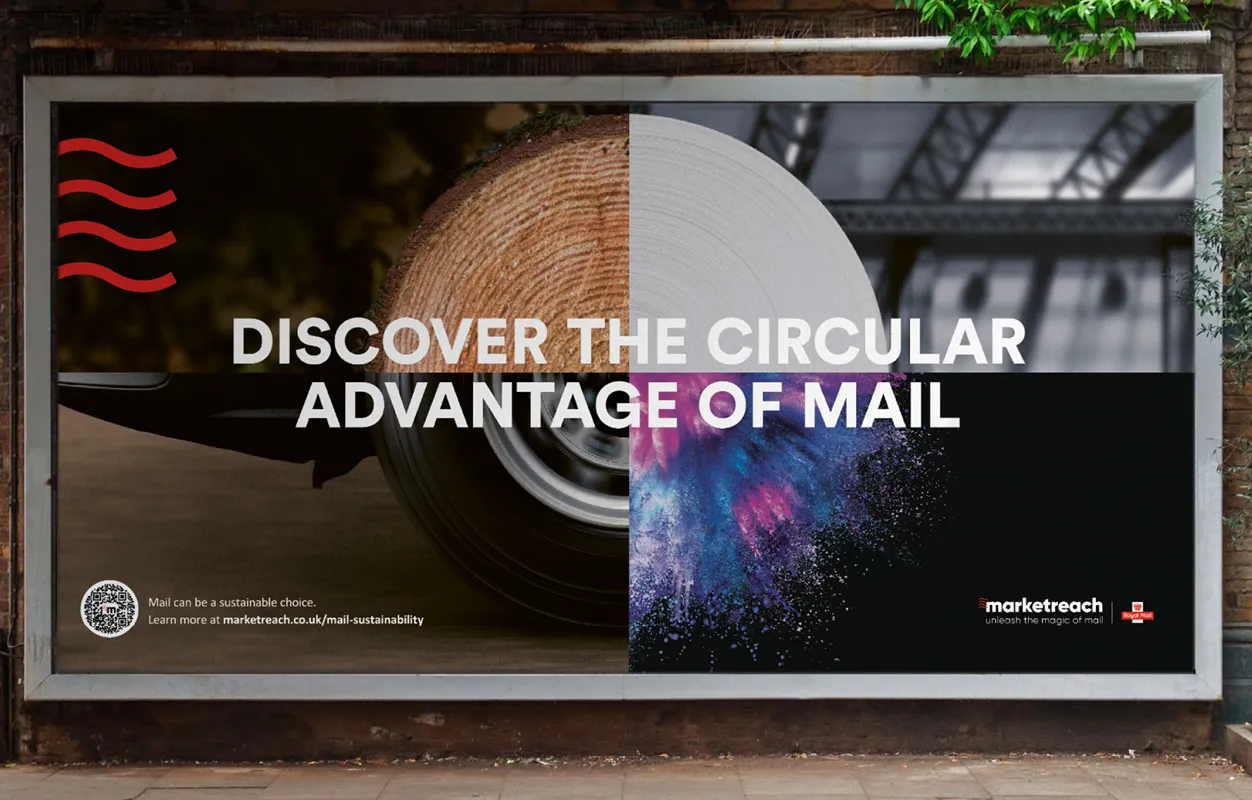Why sustainability first makes sense for marketers

Tackling the environmental challenge can appear daunting; the scale of the problem can leave businesses and people feeling powerless. But incremental changes made at a granular level in business or by individuals can add up to billions of meaningful actions that combined can stop the increasing rate of global warming.
And then we can begin to start lowering carbon emissions overall, reversing the rise in the earth’s average surface temperature that started in the 19th century 1.
Why mitigating environmental impact must be the top priority
The past eight years have been the hottest on historical record
Source: World Meteorological Society
The first task is to dismantle business resistance to the idea that global warming is an abstract concept and that organisations can continue conducting “business as usual.”

It’s a well-known fact that the human impact on the environment has snowballed over recent decades and now threatens all species on earth – including our own race. Pollution from industrial processes, manufacturing and transport, to name just three sources, is damaging our eco-sphere - the air, water and land. There are huge implications for our health and fertility, our ability to grow and harvest crops and our livestock and sea food strategies.
But the most immediate effect of human actions on the natural world can be seen with climate change and global warming. The earth’s temperature has risen by an average of 0.14° Fahrenheit (0.08° Celsius) per decade since 1880, or about 2° F in total, and the rate of warming since 1981 is more than twice as fast2. We can see the impact in so many ways, including unpredictable weather patterns, drought and shocks to the planet’s biodiversity.
If the rate of increase of global warming is not stopped and then reversed, we face drastic consequences. As one of the founders of the first European Green political party recently said: “The battle for the world's environmental survival is, at this moment, lost. It doesn't mean to say that we can't perhaps do other things to put things right, but it's a very dire situation that we have.”3
Sustainable practices make business sense
Ensuring the planet is a sustainable habitat for humankind and our fellow species should be the only reason needed to change practices, processes and business operations. But if shareholders and the C-suite still need convincing, there are practical commercial reasons to act.

- Scarce natural resources are finite and the laws of supply and demand will inevitably drive up costs, so alternatives must be found
- Consumers want brands to act sustainably They are willing to switch brands if they don’t meet expectations and are increasingly willing to call out any “greenwashing” marketing claims4
- Likewise, investors and potential partners now also audit company Environmental, Social and Governance (ESG) policies. Your business may find funding hard to come by on your next investment round if sustainability isn’t taken seriously
- Governments and policymakers will also favour companies that can prove they have positive societal impact and can operate without depleting a country’s natural resources. The 17 Sustainable Development Goals developed by the United Nations can help provide a framework for cooperation and collaboration on tackling climate change5
- People increasingly want to work for organisations that hold values like their own – and that includes ensuring social wellbeing and protecting the planet
The commercial argument for investing in the transition to be part of a low-carbon, truly sustainable economy is watertight - but it’s also understandable that many brands can’t become 100% sustainable in a short time.
Many of the sustainability targets set by governments and adopted by industries have a deadline of 2030. Why? As the United Nations statement on Net Zero says: “To keep global warming to no more than 1.5°C – as called for in the Paris Agreement – emissions need to be reduced by 45% by 2030 and reach net zero by 2050.” 6
The 45% reduction target is key and if businesses become more sustainable, albeit imperfectly, they will have a measurable impact on reaching this goal.
Marketing has a big part to play in reducing environmental impact
The question each business must consider is “how can we change or adapt our products, services and supply chain to move towards a more circular, sustainable approach to our operations and processes?” How can a business shift focus from designing products for single use to designing for many life cycles and users – and at the same time optimise for the environmental effects of the materials used?
These are challenging questions for every sector including marketing, which is often under fire for encouraging over-consumption. Now benefiting the planet needs to be at the forefront of marketing decisions.
There are conversations in creative agencies to address storylines that show unsustainable lifestyles - for instance, should ads be depicting one person car use? But the essential place where marketing can start making a difference is in creative and media production and distribution processes.
The first step should be understanding the amount of carbon emissions generated by all parts of the production and delivery process. Then marketing stakeholders can start exploring alternatives and how they can act more sustainably.

How the industry is co-operating to benefit the environment
No one brand or organisation will turn the tide alone. Finding and implementing solutions to the sustainability challenge must be an industry-wide mission. It is encouraging to see positive moves from marketing industry bodies to provide help, information and roadmaps towards more sustainable practices.
The most high-profile initiative is the UK Advertising Association’s Ad Net Zero, also recently launched in the US, which is described as “the advertising industry’s drive to reduce the carbon impact of developing, producing and running advertising to real ad net zero.”7
These efforts also embrace digital media, which is far from “clean” in terms of carbon emissions. The carbon footprint of gadgets, the internet and the systems supporting them account for about 3.7% of global greenhouse emissions, according to estimates and is similar to the amount produced by the airline industry globally.8
There are many hidden environmental costs that need to be considered. For instance, cloud computing presents problems - vast amounts of electricity is needed to keep systems powered and cool, while there is e-waste generated when equipment needs replacing. The leading cloud providers are trying to tackle the impact of cloud energy consumption – e.g. Google has managed to be carbon neutral since 2007 via its use of renewable energy and carbon offsetting strategy.9
At a granular level an email with attachments has an average carbon footprint of about 50gCO2e, so the Green Supply Path initiative from the IAB “to promote visibility into and accountability for carbon emissions across the digital advertising ecosystem” 10 is very welcome.
There are now a number of resources to help marketers, including carbon calculators for different media produced by agency networks like Group M, dentsu and WPP.11
How mail including direct mail is making its journey to improve sustainability
The issues involved in becoming more sustainable are complex and marketers have plenty of other priorities that feed into decisions – including how to operate effectively and efficiently in a depressed economy where budgets are being squeezed.
And sustainability is not purely the marketer’s job; it needs to be taken on board by all departments in a company. Businesses are waking up to this and according to LinkedIn ‘sustainability manager’ is the second fastest-growing job title in the UK.12
But the decisions on media, materials and relevant partners does rest mainly with senior marketers and their creative and media agencies. At Marketreach we are committed to helping our clients and partners and are working collaboratively with the mail industry to improve the sustainability of mail as part of the media mix.
We have invested in understanding the carbon impact of the mail channel with an independently commissioned Life Cycle Assessment (LCA) from experts WSP. The LCA examines the carbon emissions generated by a variety of mail formats ranging from postcards to large catalogues. This is helping us to understand the end to end carbon impact of mail from raw materials through to landfill and the ways in which the manufacturing and distribution process can become more sustainable.
Reducing the environmental impact of mail
There are ways to reduce the environmental impact of manufacturing and delivering mail. By taking every opportunity to regenerate, reinvent, reduce, reuse and recycle mail during its lifecycle, it can be part of a circular, regenerative economy.

Let’s break this down further:
- Paper comes from a natural, regenerative crop. Using paper that only comes from sustainably certified* forests is an essential first step as trees can be replanted, help to draw down carbon from the atmosphere and contribute to biodiversity
- There’s been a steady reinvention of paper mills and printing processes to be more sustainable and efficient. Low-impact modern paper mills run on 100% renewable energy, use total chlorine-free processes and recycle most water involved, while low-carbon, energy-efficient printing processes can use biodegradable and water-based inks
- Impact of distribution can be reduced with tight targeting and an efficient delivery plan. Royal Mail is decarbonising its distribution fleet, switching to renewable energy and using more electric vehicles, electrifying operations, finding low-carbon solutions and ensuring van loads are more efficient
- Reuse and recycling are embedded in mail production. A piece of paper is reused 3.8 times on average, and sometimes up to seven times depending on the fibres – it is the most recycled material in the world.13
Practical strategies for sustainable campaigns
An environmentally positive approach to a mail campaign will mean making decisions on balancing strategic goals with the carbon cost of your mailer. The first step should be to look for a like-minded supplier, so look for partners sporting recognisable credentials, such as B-Corps status or Carbon Balanced Printers.

Before focusing on design and production review your mailing database so that it is up to date – this lessens wastage and the associated carbon emissions. Then see which of the below actions you can build into your campaign strategy:
- Using a format and sustainable materials that minimise waste
- Balancing the weight of the mailer with your desired objectives
- Reducing the impact of the end-to-end production process
- Checking if the carbon cost of delivery can be reduced
- Encouraging customers to recycle or compost biodegradable materials
- And as a last resort, offsetting any carbon emissions left
Not all the opportunities to reduce impact can be embraced in a single campaign. But the above points can help with initial planning and are applicable whatever the size of a business. You can find plenty more helpful advice in our guide Using Mail More Sustainably.
Case study: The sales and production cost benefit of applying a sustainable mindset
Eastons Holidays is a Norfolk-based coach holiday company. In the highly competitive “staycation” marketplace of 2021 it needed a highly targeted, creatively impactful and cost efficient mailpack. It worked closely with print agency Eight Days A Week Printing Services (EDWPS) to refine and segment its customer base for a smaller, more efficient list.
The challenge: The company’s standard mailing was a poly wrapped multi-item mailpack that didn’t qualify for machinable mail discounts or responsible/sustainable bulk mail discounts. Also, Eastons had concerns regarding the negative eco nature of single use plastics.
The solution: EDWPS created a paper wrap alternative to poly wrap, so the Eastons’ mailing could benefit from both machine processing and sustainable bulk mail discounts. The brochure and multiple inserts, in a colourful, durable packaging, stood out on the doormat. By changing the format of the brochure in terms of page count and using the paper wrap process, a far superior, high-quality finish was also achieved.
The results: Production costs were reduced by 50% through a combination of postal discounts qualification, removing unmailable records and sending targeted mailings to segmented groups. This eliminated unnecessary spending and increased ROI immediately by 20%. A more targeted mailing also produced improved sales – Eastons experienced a 400% uplift in daily bookings to over 200 by four weeks after the mailing landed.
Conclusion
There’s no doubt that the path to sustainability is a journey and we are underway in improving the sustainability of mail.
You can learn so much more about how mail can contribute to a circular economy by visiting https://www.marketreach.co.uk/sustainability You can also find tips and ideas on how to produce more sustainable mail campaigns in our guide.
Designed in the right way, informed by the right tools and data, mail can be part of a circular, regenerative economy.
- https://www.wired.com/2016/08/human-induced-climate-change-going-longer-think
- https://www.climate.gov/news-features/understanding-climate/climate-change-global-temperature#:~:text=According%20to%20NOAA's%202021%20Annual,0.18%20%C2%B0C)%20per%20decade
- https://www.bbc.co.uk/news/uk-politics-64815875
- https://about.ads.microsoft.com/en-gb/blog/post/december-2021/consumers-are-ready-to-switch-brands-for-sustainable-alternatives
- https://www.ey.com/en_gl/assurance/why-sustainable-development-goals-should-be-in-your-business-plan
- https://www.un.org/en/climatechange/net-zero-coalition
- https://adnetzero.com/
- https://theshiftproject.org/wp-content/uploads/2019/03/Lean-ICT-Report_The-Shift-Project_2019.pdf
- https://earth.org/environmental-impact-of-cloud-computing/
- https://www.iabuk.com/news-article/iab-tech-lab-launches-initiative-reduce-carbon-impact-digital-ads
- https://www.campaignlive.co.uk/article/groupm-scope3-develop-omnichannel-carbon-planning-tool/1813758
- https://www.ft.com/content/8412db41-dce1-44a7-9417-25a3a534ee54
- https://www.twosides.info/UK/environmental-benefits-of-paper-recycling/





